Written by Abhimanyu Vinay Rajput (TTT Subscriber El Indio).
(*This article was first published earlier this week for subscribers only, but because of the high standard of the analysis and incredible effort put in by El Indio, we have now made it free to everyone, so get sharing!)
When you get to intermediate level of your cross fit class, there is an introduction to a box.
Yes really.
Gym equipment. A box.
The trainer will explain that you’ll need to strengthen your lower body. (Anything below your waist is considered as your lower body)
S/He will also throw some jargons related to your body.
“Your glutes, calves, hamstrings and quads need strengthening!”
And jumping on, and off the box will be one of the exercises.
There are many advantages you will be told. Ranging from ability to strengthen parts of your body to improving agility to burning calories or melting fat. Or you’ll look much cooler that your jumping on a box of considerable height and jumping off. Take your pick from the bunch.
We used to do this when we were children. Hundreds or thousands of times. Jumping off, jumping on. We are after all descendants of the great ape (or the Hominid family as science tells us)
There is an interesting thing when you jump up, and down from a box.
There’s an elevation in an instant.
Consider it again as what occurs. There is a jump. Instant elevation. Repetition of this means you can master a certain height of box. And then you take the next level.
But a jump is not the only way to reach from a defined point A to point B.
(Apparently there is a limit to how high you can jump. The Guinness World Record for the highest standing jump by a human is 5 feet 3 inches. By contrast a Grey Kangaroo can broad jump 44 feet. Likewise, a Dolphin can do a good 23 feet)


Multiple steps can be made to ease the movement from point A to point B. It is easy to execute, produces less strain but takes time.
A jump though is something different. It is difficult to execute, produces an instant strain across your body (or your bum if you fall) but takes less than a second to execute.
It is highly rewarding if you maintain consistency. But jumps are also steps when movement is considered vertically, and horizontally. So, it really is a step-jump if you are going to move horizontally-vertically on the axis.
And why is this important?
We realised in 2018 that Liverpool were making strides with marginal gains. However, over the period it is said that Liverpool have taken this to a new level. Of course, having an opposition like Manchester City helps to improve a lot but there are 18 other teams that keep trying to outwit Liverpool.
As Liverpool finished second with 97 points, a moment of banter for Twitteridiots to rejoice in, there was a level of expectation that Liverpool would collapse the following season as they did in 2014-15, and 2009-10. (Albeit completely different circumstances as 2009-10 was played in the background of a club civil war with a fractious supporter base, and in 2014-15 we just sold our best player on the pitch, and never replaced him)
But Liverpool came out flying into 2019-2020 as if there was a new unfound trajectory.
Suddenly everything looked more like marginal but more jumps even though Liverpool hardly added any new personnel. Everything was known but it seemed like everyone else was in the unknown.
This begs the question, could anyone figure out when the jumps started? Or when did the gains become so big?
People talk about going game to game – no, we commit session to session. Small things make big things happen. You have to focus on doing the small things right constantly
Pep Ljinders interview with the Athletic’s James Pearce
Before we get there, how do we measure a gain, marginal or step?
What does a marginal gain look like?
If your answer is that marginal gain is linear, you are in the majority despite being a little off in terms of assumptions.
A gain of 1% everyday would be assumed as (1% x number of days of improvement x base value before improvement)
So, a 1% everyday gain over 420 days with a base value of 1 would be:
(1/100) x 420 x 1 = 4.2 times of 1
Something like below:
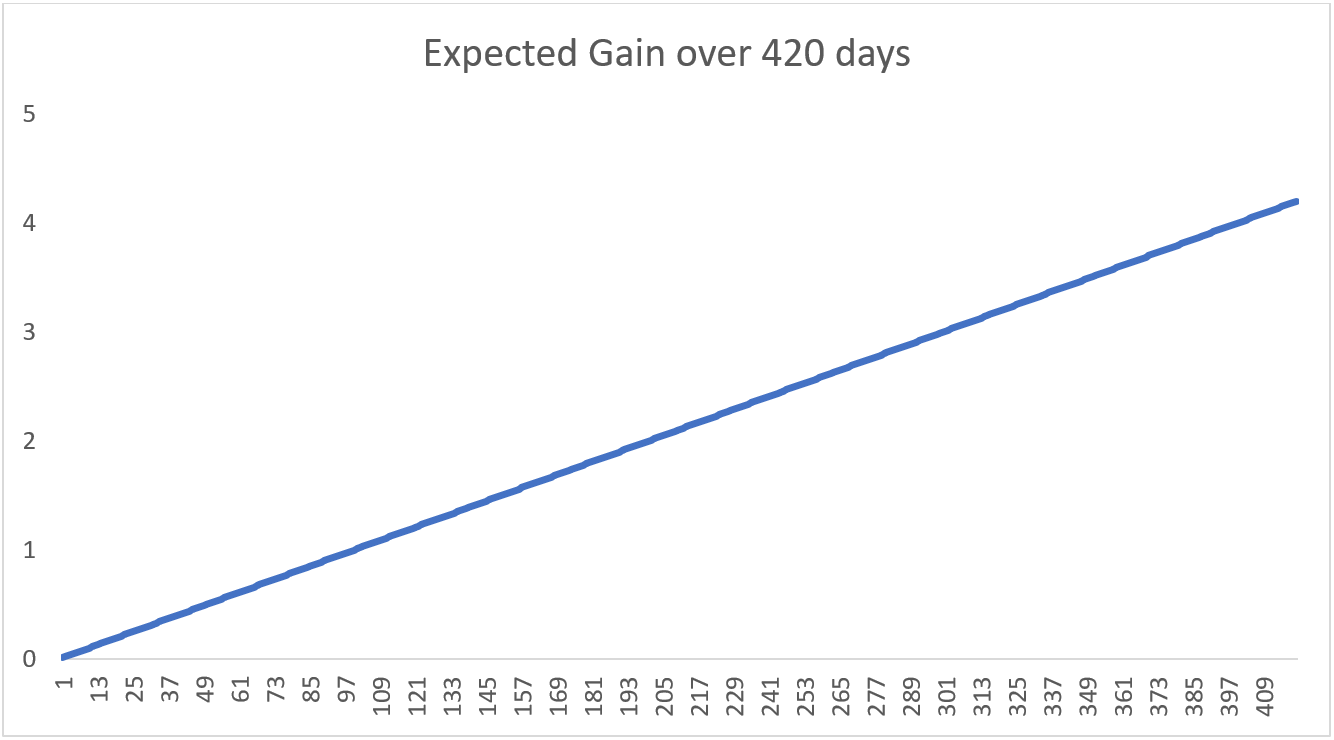
However, this is not how it works.
As the base value keeps changing due to earlier gains applied, the marginal gain is not a line but rather a curve.
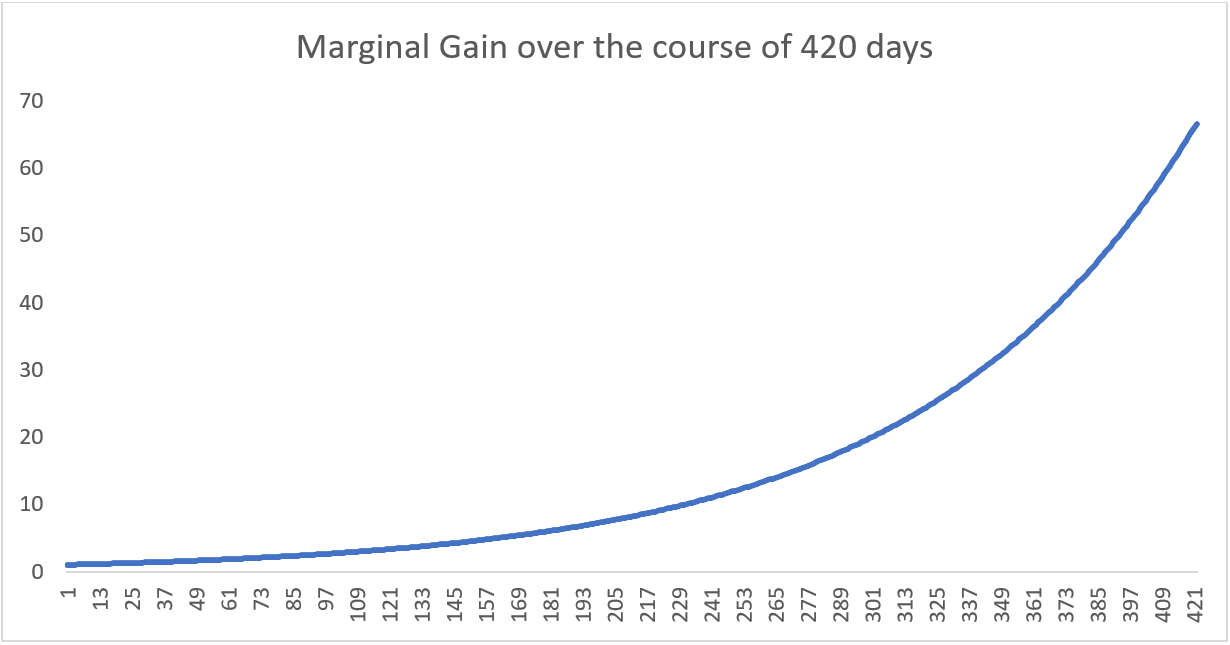
But what if there were many gains. Like a hundred gains? Or maybe a thousand gains, or a million? Where does it all add up to? How does it all add up to?
There is no straight answer to it unless we track gains and can identify each of them in a distinct manner. But if you simulated many gains, they would represent a step-jump.
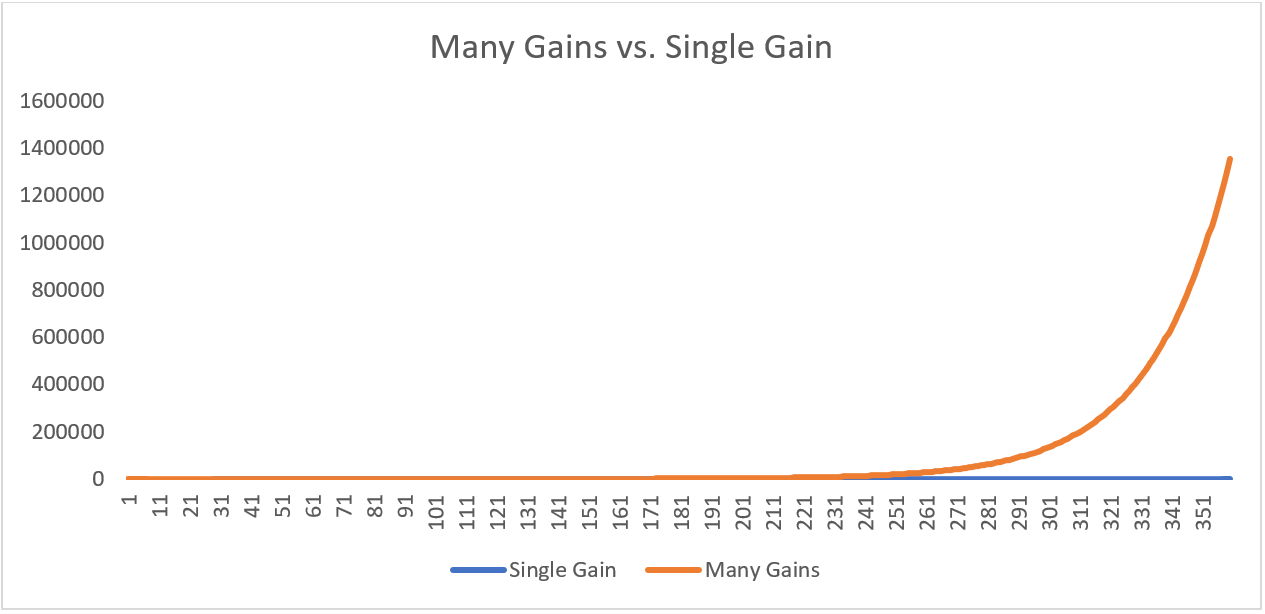
And how are Liverpool doing it?
It seems Liverpool have been completing these in phases. We could say there are at least five things that Liverpool have implemented:
- Creation of elite level gains environment with elite staff
- Acquisition of players who fit the system, and the team
- Competition of among elite players
- Keep changing tactics either in game or for the season
- Figuring out blind spots in the game
The following is an attempt to understand what caused Liverpool to step jump.
The Summer of ‘69 ‘16
In the summer of 2016, the gates of Melwood graced a total of six players as 16 players bid adieu to Liverpool forever.
While Mané lit up the Premier League until his mid-season departure for the African Cup of Nations, Wijnaldum, Matip and Karius became regular starters with Klavan filling in as a substitute whenever required.
But these players weren’t the only significant acquisitions for the season.
Two FC Bayern München back room staff also arrived with less fanfare.
Andreas Kornmayer, the Klopp lookalike drill Sergeant, and Mona Nemmer, the nutritionist.
Gegenpressing was the fad word as Klopp arrived at Liverpool. And in his first match with a disjointed squad, Klopp made them do something remarkable. In his first match in-charge, Liverpool outran the fittest team in the Premier League, Tottenham Hotspur, beating them by 1.2 kms (116 km vs. 114.8 km). A team that used to average under 100 kms combined somehow conspired to run more, press more, and deliver more.
But as Liverpool hit strides, there were setbacks. The most massive one was the Europa League final in Basel. Seville had been plastered for 45 minutes, and then turned the tie round with an equaliser 17 seconds into the second half. (What is it with the Spanish teams and Liverpool?) [Apart from Barcelona! – Ed].
And you don’t hire two influential backroom staff from German champions without a plan.
As Liverpool began the new season at the Emirates stadium, they ended up with a 1-1 half time scoreline. It is at this moment Klopp urged his players to run faster as they had done during the summer. Forget running, Liverpool players ran riot. Arsenal weren’t the only victims that season as Liverpool powered to the top of Premier League by November. While Wenger, who championed fitness and nutrition, bemoaned physical shape as Liverpool with their highest representation from Euro 2016 arrived to run a marathon at the Emirates.
This season, almost three years on, Liverpool did the same thing to Arsenal during the 3-1 win at Anfield. Liverpool went full throttle in terms of intensity which Klopp pointed out in his post-match press conference.
There are two things that have made Liverpool tick. Food (fuel) and pressing/counter pressing (Running also known as burning the fuel).
And Liverpool make step jumps not just with new signings but with this environment allied with experts.
Better me, better you, better us.
Uefa’s analysis graphics depict him as a static blob, but really Milner’s blob should be blurred with motion lines, reflecting an approach that basically involves embarking on a series of unrelenting sprints from box to box, like a man very stubbornly doing lengths of a swimming pool while a water polo match goes on all around him.
Match report by Barney Ronay for England’s Euro 2012 before the penalty exit quarter final match against Italy
(Source: Barney Ronay Guardian Football Blog)
Football is a sport which requires running. Running means, you need your body in the best physical shape and not only for undergarment adverts.
And we have seen how seemingly good careers descent into string of shocking performances.
Yet of all the simplistic correlation between performance decline with age, Milner has been winning the annual pre-season running tests. Two years in a row.
In 2015 while plying his trade with Manchester City, Milner broke the distance covered record for the season at 13.56 kilometers. He scored, assisted a goal, and ran all over Stoke City.
(Source: OptaJoe)
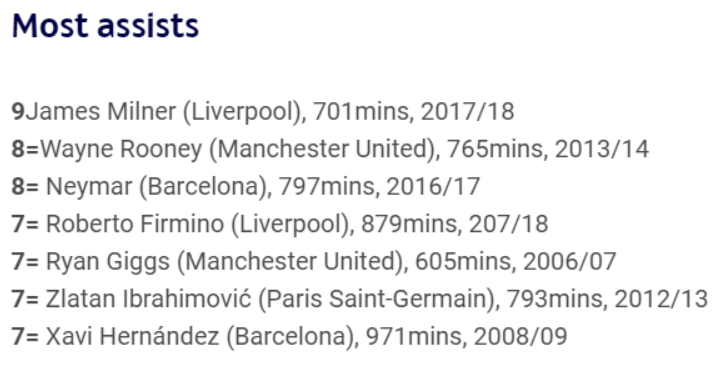
(Source: UEFA.com )
Three years later his erstwhile employers were at the receiving end. While Liverpool put a collective five goals past Manchester City in the Champions League Round of 16 tie as they marauded their way to the final, Milner covered a stunning 13.53 kilometers in the return leg. He also broke the Champions League assists record for the season during the 5-2 win over Roma at Anfield.
"James Milner's legs have gone." pic.twitter.com/fv9aipFyYf
— SH (@Sennesation) April 10, 2018
Every year Liverpool have signed a midfielder, and somehow every year James Milner makes it on the pitch.
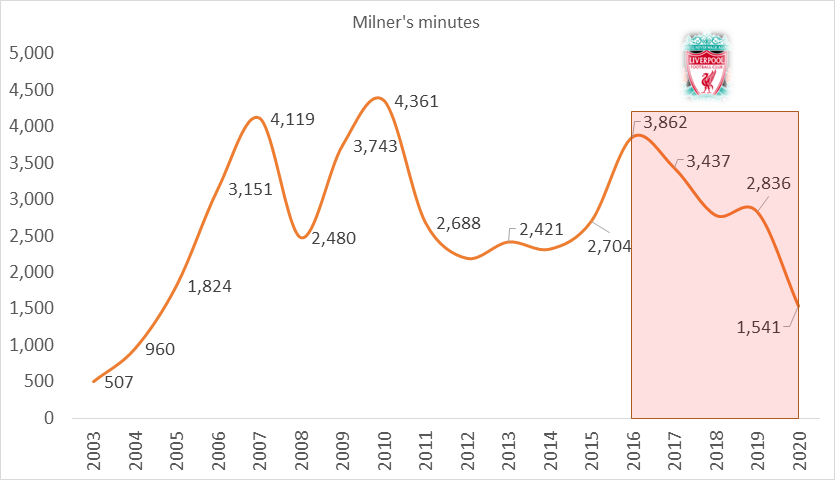
(Source: Transfermarkt – Player profile James Philip Milner)
Milner by being on the pitch and fulfilling roles as a full-back on either side of the pitch or being in every position of the midfield is pushing new acquisitions, existing squad players, and even academy graduates a benchmark to beat.
An article by Pedros Passos, Duarte Araujo and Keith Davids on the competitiveness within a team concluded a couple of things:
- Players seeking to improve chances of team selection will compete against each other, hone skill over time, and become more functional towards delivering performances over time. Thereby enhancing their role within the team, and solutioning situation against opponents.
- Players respond to different situations by adapting to the environment, and opponent thereby creating different action possibilities (= affordances). Affordances captures the fit between an individual, and the environment the individual faces. In order to action on affordances individuals can rely on physical attributes, creative yet risky moves with enhanced perceptual ability or even conservative moves in coordination with other individuals.
- Jumps/transitions occur through the game as players not only need to coordinate for intra-team performance but also balance the attack-defence stability in inter-team interactions. In a game, a jump may occur from the current game state if there is any change in essential variables (Like increased usage of dribbling ability on side of the pitch creating a situation favouring the attacking side, and putting the defending team at a disadvantage). Training for these situations can vastly improve the performances of the individuals, and intra-team performance.
- Players also co-adapt to new skills over time as the environment of team-mates, coaches, and sport science staff pushes them to keep improving individual performances by harnessing competitive behaviour.
(Source: Competitiveness and the Process of Co-adaptation in Team Sport Performance by Pedros Passos, Duarte Araujo, Keith Davids.)
A team like Liverpool is pretty much ahead on the learning curve as the wealth of experience (Champions League runners up, Europa League finalists, Premier League runners up), elite performers (attacking trident of Mo Salah, Firmino, and Mane lining up against elite full-backs like Trent and Robertson while training against an elite centre-back like Van Dijk, and trying to score past an elite goalkeeper like Alisson), and an elite technical staff armed with excellent data science team create a co-adapting highly competitive environment.
They can make a difference tonight, we need everyone on the top of their toes”
Pep Lijnders message to Liverpool staff to instruct ball boys to throw back balls quickly
(Source: Guardian interview with Pep Ljinders)
The most famous outcome was the second leg of the European semi-final against Barcelona. While the Camp Nou score line was harsh, the reverse fixture at Anfield altered every aspect of the game. Liverpool’s competitive advantage came from the stands to the players, despite being at a tactical disadvantage, with some inspired analytical input and coaching inspiration leading to a moment of brilliance that knocked out a European elite team with arguably one of the elite performers in the modern game. Sometimes even ball boys can alter the game.
(One of the more interesting observation throughout that game was the massive difference in each team’s identity. Barcelona’s identity was for looking for space and passes. Liverpool’s identity was intensity derived from pressing/counter-pressing. It is no coincidence that all of Liverpool’s goals were either from pressing or counter-pressing at specific situations)
And all of this occurs because Milner pushes for 130 kilo leg presses during the off-season, so that he can be the winner of the preseason lactate tests.
(Source: FourFourTwo’s guide to offseason with Milner)
Elite jumps of preseason
Apart from the games during the season, it (preseason) is the most important thing and it has a big influence on the games. You create a base for the whole year. This game is a players’ game and the players’ game means they need to know what the other guy is thinking.”
Klopp on the importance of preseason
In the summer of 2017, Liverpool travelled to the Far East.
The video is side field view of Liverpool training. There’s Buvač, Klopp, and Krawietz visible on the field in training gear. Ljinders is there as well, because you can hear him shouting.
The squad is divided into two groups on a half-length of football pitch. One group has Mané, Salah, and Firmino (for the sake of simplicity, I’m going to call their group FSM) along with midfielders and defenders. The other group has other strikers as well. The structure of the exercise is simple: once the ball is launched from either side the whole unit starts moving to attack. The attacking unit is then stopped as another ball is launched to the other group and the attacking group needs to reorganise, and then defend. On any given day it looks an exhausting and boring exercise, but if you give it more of a look you realise how good the group became with each interplay.
The FSM group looked brighter and off the blocks each time one of them had the ball with them. They were rotating positions, but the key idea was a blitz.
If we called this Phase I of game play, it had terrified teams during the 2017-18 season. Arsenal and West Ham were the first recipients of such a blitz. And both plays started out from the back, either a corner or a ball deep inside Liverpool’s defensive third.
Slowly the same game play crept into Europe. Liverpool’s first Champions League campaign in almost a decade saw them swatting sides left and right. Pep Guardiola and his assistants worried about this before the crucial away leg at Merseyside. By the time City visited, the FSM trio had clocked 1,000 minutes together. When Alex Oxlade-Chamberlain joined the party, Liverpool were 2-0 up, and on course to their biggest European win against anointed semi-finalists. It almost worked in the final of the Champions League but once Salah was out of the game, the complexion changed completely.
In the 2018 preseason it was more interesting. Apart from the usually bleep testing and double Rondos there was an interesting exercise.
Like 2017 preseason, there were two groups but this time the goalkeeper is involved for passing movements. The length is much shorter, meaning scoring goals is easier while ‘keepers have to be on their toes (and soft knees for quick reflex saves).
It seemed some of our play had evolved with the back four waiting and waiting before splitting the opposition apart through the middle or even the flanks.
This surely can be called as Phase-II.
Marriage between both the phases took time since we were integrating a new style with a new goalkeeper, a midfielder, and a winger.
But every preseason Liverpool either had new acquisitions creating step jumps or a new style of play that would clearly beat opponents by a mile during the game.
Take for example the arrival of Mané at Liverpool in 2016
Allied with the movement of Lallana, Firmino, Coutinho, and a preseason, Liverpool took goal scoring to a new level in the Premier League.
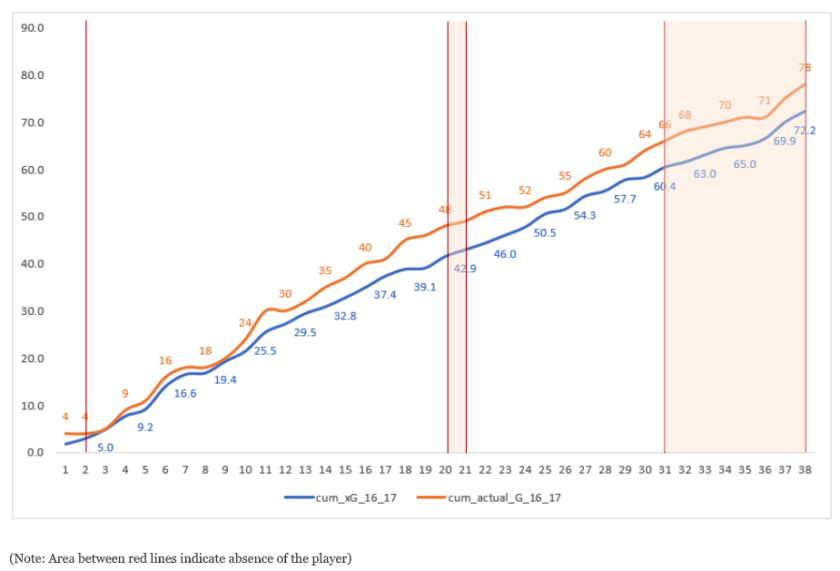
And then Salah joined the party in the summer of 2017 as Liverpool went full throttle counter attacking football.
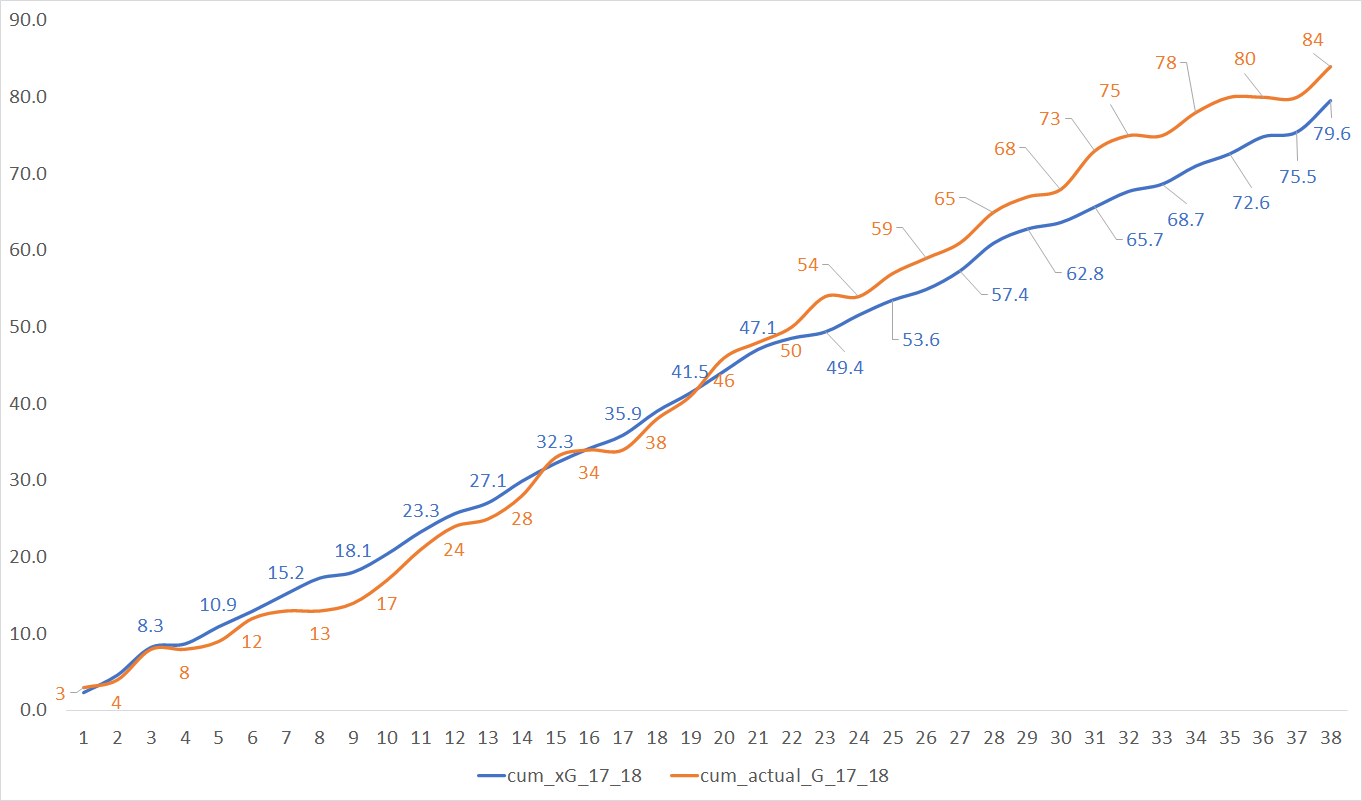
And the party continued last season (18-19 season) along with a new creative outlet from the full-backs and a measured response of when to launch the blitz.
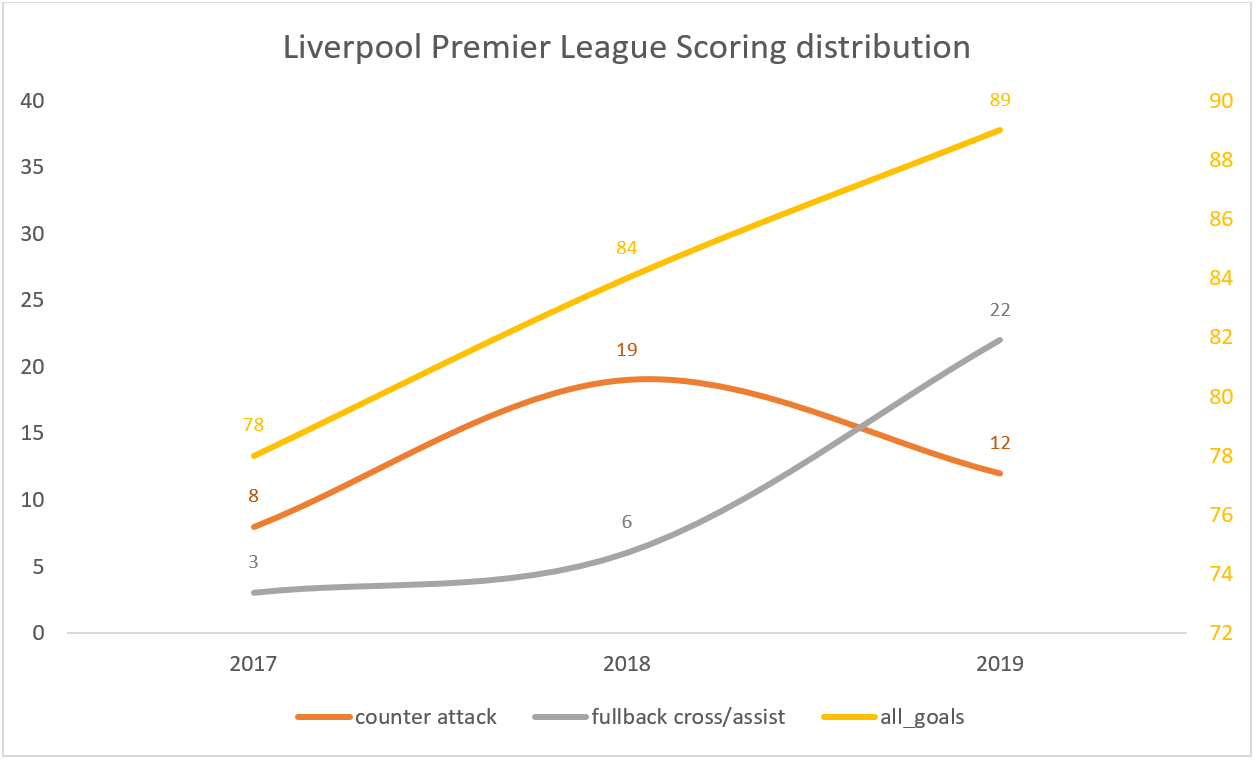
(Source: (1) All LFC goals 17-18 season (2) All LFC PL goals 18-19 season (3) All LFC goal 16-17 season)
And this season when Liverpool kicked off the current campaign, an interesting tactic was observed. Liverpool started playing a higher defensive line, had the lion’s share of possession as before, and started pressing more situationally even though full throttle pressing remained absent in many situations.
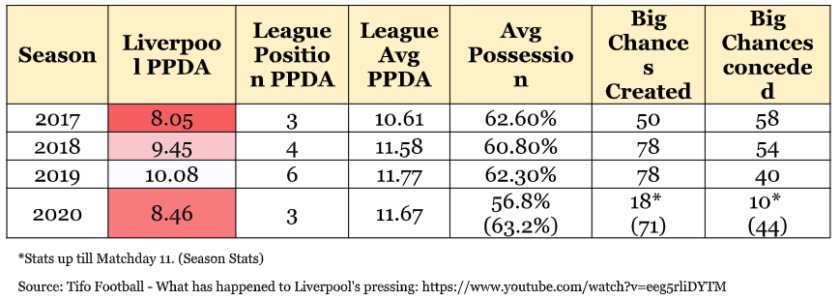
But even pressing like a Liverpool team player requires a lot of hard work. And that comes during the preseason.
It all started in preseason when we put all those miles in to get us as fit as possible. We feel as if we’re fitter and stronger than most teams and we can go right to the end. That fitness has been key and it’s enabled our quality to shine through. We’re still going strong in the 90 minute”
Andy Robertson after Liverpool’s 3-2 win against Newcastle United at St. James Park
And Liverpool’s transfer strategy seems to be getting players early for a preseason. They are then eased into the system.
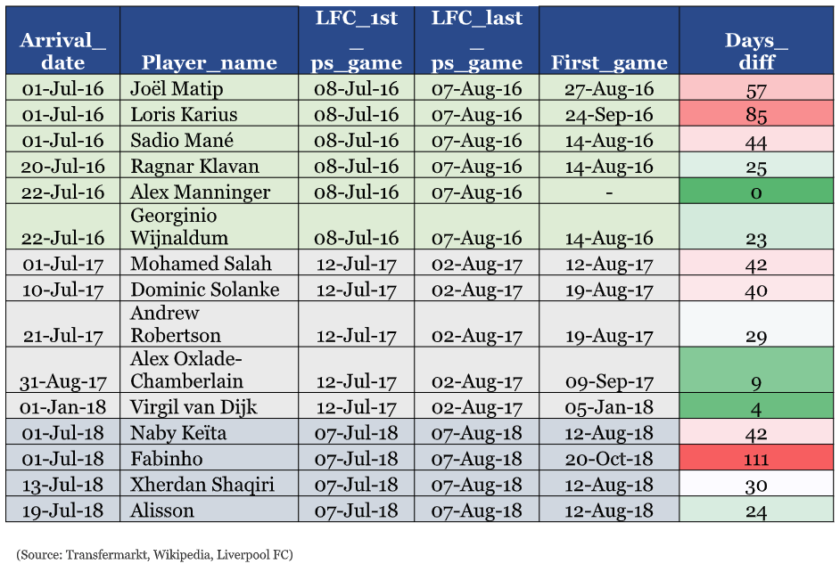
And the difference between a preseason and no preseason is quite stark. Take for example Van Dijk’s first six months at Liverpool, with no preseason, and no unit behind him (Unit = Alisson):
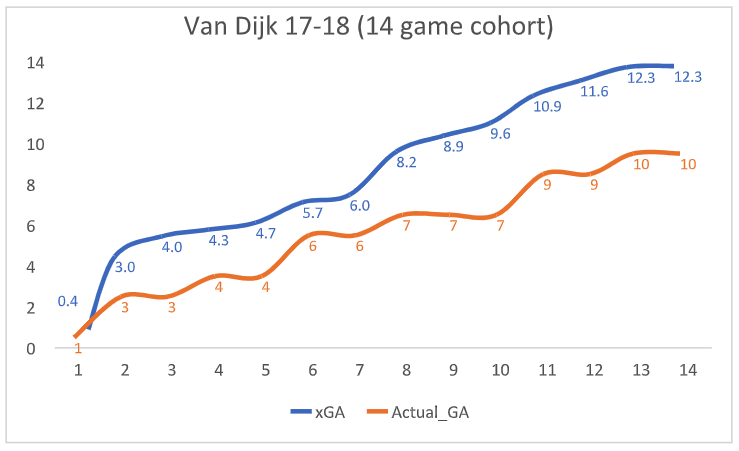
Van Dijk after a preseason with the unit (Van Dijk-Robertson-TAA-Matip-Alisson):
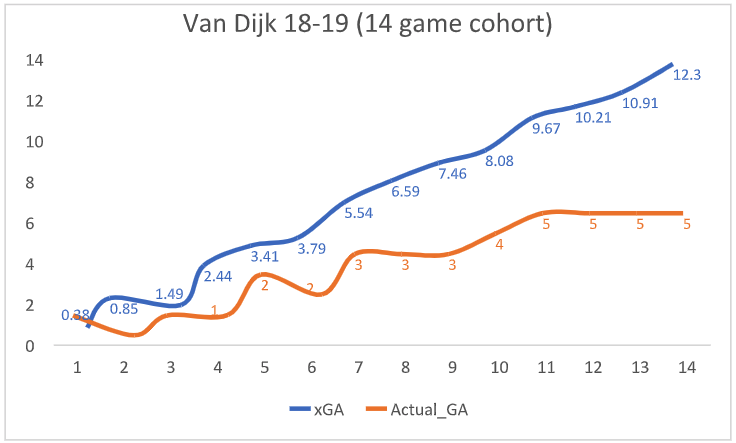
The improvement with a preseason and a new goalkeeper (in a completely different environment while adapting to a new country, and football league) resulted in a 50% drop in leaking goals while expected goals remained at 12.3 (from 10 goals conceded to 5 goals conceded in 2018-19).
Not only that but a preseason is also the difference between a losing finalist and a runner up spot to a great player but being acknowledged by one of the greatest defenders in football.
This season the best @VirgilvDijk @LFC https://t.co/IwvV4x7Rre
— Franco Baresi (@FBaresi) December 2, 2019
The form for the preseason doesn’t matter but the exercises involved in it do. Next time when a preseason video pops up, look out for those elite jumps in the making.
The Zone
You have to remember that a mountain at 8,000 metres, 26,000 feet, is the very, very top of the troposphere. So, you’re hitting the troposphere and the stratosphere, this is where planes fly.
You’re that high. Humans aren’t meant to survive there. So, when you are climbing there even if you are on oxygen, oxygen is not like oxygen in a hospital.”
Mountaineer Vanessa O’Brien on the Death Zone
The death zone is the height at which oxygen becomes more precious than anything else in the world. For context, above 12,000 feet the oxygen is at 40% lower than at sea-level, and by the time they begin their ascent above 26,000 feet they must prepare to keep their bodies alive.
Digestive systems shut down, brain or lung edema are real possibilities with possible hallucinations or error in judgment due to shortage of oxygen.
Everything must be perfect. Zero ground for error. There is very little luck involved.
Mountaineering is one of those rare sports where skill trumps luck by a huge margin. And even if there is some luck it would be more relevant to the environmental conditions including weather, nature of the climb, and availability of air. But even those calculations are considered.
How do the other sports compare? Where does football stand in the luck vs. skill argument? Where does professional basketball stand?
Michael Mauboussin has an explanation not only for sports but for every aspect of life including investing.
- Skill and luck are part of the game
- Luck can be heavily imbalanced. You can be very lucky or unlucky. There is no pattern to it.
- Skill can be measured better over a large series of events/games
- Streaks either winning or losing are an indicator of skill
- Reversion to mean plays a powerful role in activities guided by pure luck. In activities guided by more skill, and less luck, it has lesser or negligible influence
- Transitivity (or ranking of teams based on skill) does not represent a clear picture in team sports. Rather it falls on the coaching staff to innovate. An elite coaching staff with plans to introduce every coaching strategy could do well even without elite athletes
(Source: Untangling Luck, and Skill)
While drawing these conclusions, Mauboussin also placed various sports on the skill-luck spectrum. And below seems to be the likeliest outcome.
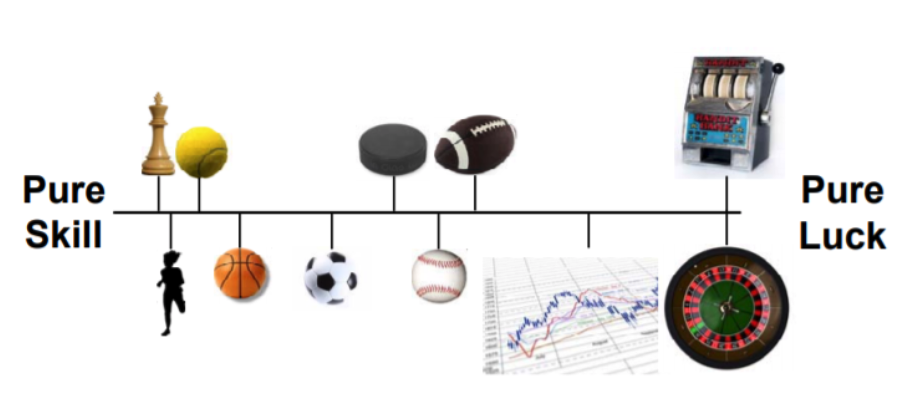
The NFL, and the markets are closer to the slots machine, and roulette table than it is to chess or professional running.
Professional football is somewhere closer to chess, but cup competitions can be quite absurd.
Take for example our defeat by Real Madrid in the 2018 Champions League final. With one event of extreme misfortune, Real Madrid’s last two goals had a combined xG of 0.05. One of them was a worldie but it only occurs less than three times in hundred attempts.
xG Highlights for the 2018 UEFA Champions League Final.
Data by @StrataBet#LucidAnalytics pic.twitter.com/nn32p4GQhQ
— Riley Wichmann (@Lucid_Analytics) June 2, 2018
And while the Champions League has elite teams with elite staff and players with the X-factor, even winning teams need luck from time to time.
I thought about quitting because, after Istanbul, nothing made sense any more. The 2005 Champions League final simply suffocated me. To most people’s minds, the reason we lost on penalties was Jerzy Dudek – that jackass of a dancer who took the mickey out of us by swaying about on his line and then rubbed salt into the wound by saving our spot kicks.’ … I could hardly sleep and even when I did drop off, I awoke to a grim thought: I’m disgusting. I can’t play any more. I went to bed with Dudek and all his Liverpool team-mates.”
Andrea Pirlo in his autobiography describing Jerzy Dudek
(Source: Andrea Pirlo’s biography – https://www.balls.ie/football/yet-absolutely-brilliant-quotes-andrea-pirlos-autobiography-119647)
Even we were recipient of the greatest streak of luck when we beat AC Milan in 2005.
The Dudek save should have gone in. Yet somehow he saved it. Not just once but twice. And then saved spot kicks, which has troubled every Milanista since 2005.
(The 2005 final would be heralded as one of the greatest sporting comebacks, would be part of every Top 10 Champions League finals list, and would inspire a whole host of comebacks based on that comeback!)
But league form is completely different. You can deceive with a series of fortunate wins or downright luck, but you can’t fool everyone through the course of 38 games.
And in many cases, you need to be in the zone to win it because let’s face it, no team prepares the preseason to be relegated.
Teams like Arsenal and Manchester United, before the Abramovich wealth kicked in, always remained in the title zone (between 1st and 4th place) through a mixture of world class player acquisitions, elite coaching, peak physical condition, innovative tactics, and world class managers like Wenger and Ferguson.
But once either manager left their respective organisations, they have floundered for many reasons except United’s 2nd place finish in 2018.
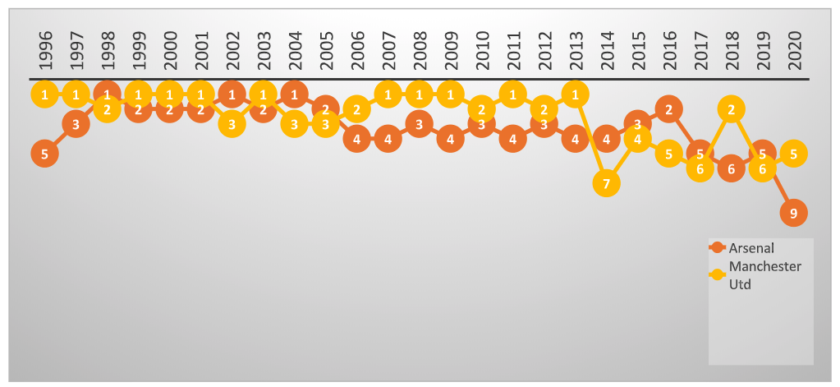
Likewise, if you looked at every Premier League champion past position there are very rarely step jumps like the ones produced by Chelsea, and Leicester.
This is also where reversion to mean occurs if there are not consistent enough finishes within the title zone. Teams between 1st and 4th place can always push for a title challenge the next season but they effectively need to be part of the zone. In Chelsea’s case it was a mixture of a dysfunctional season with Mourinho sacked for the second time after a dressing room crisis, while in the case of Leicester City every top 4 team under-performed including Tottenham Hotspur, who went from title challengers to third place in a matter of weeks.
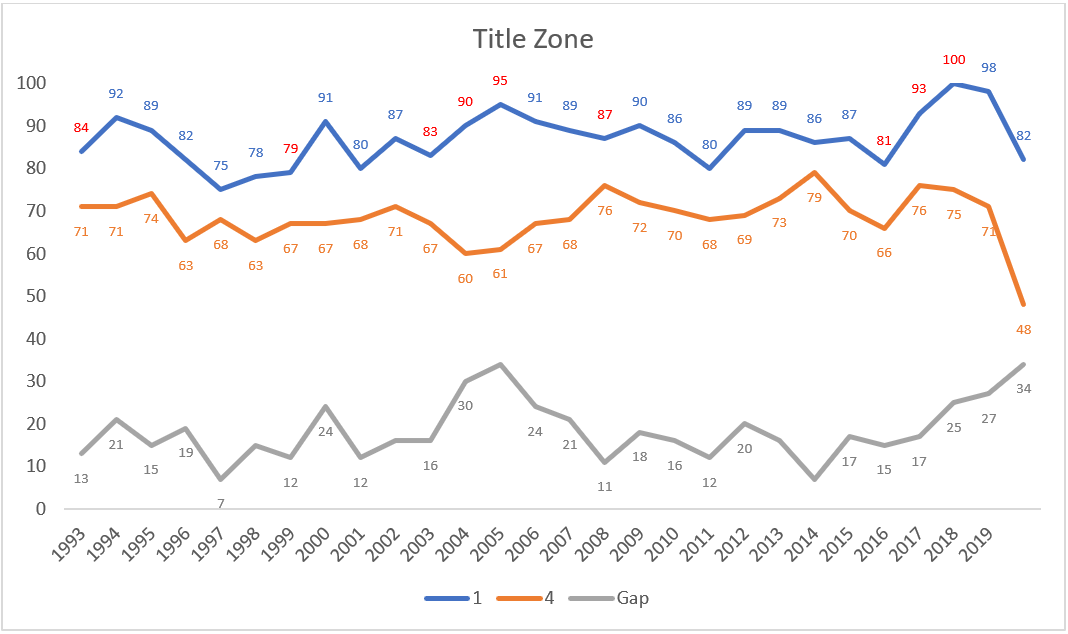
In the case of Liverpool though, they were firmly in the title zone in Klopp’s first season.
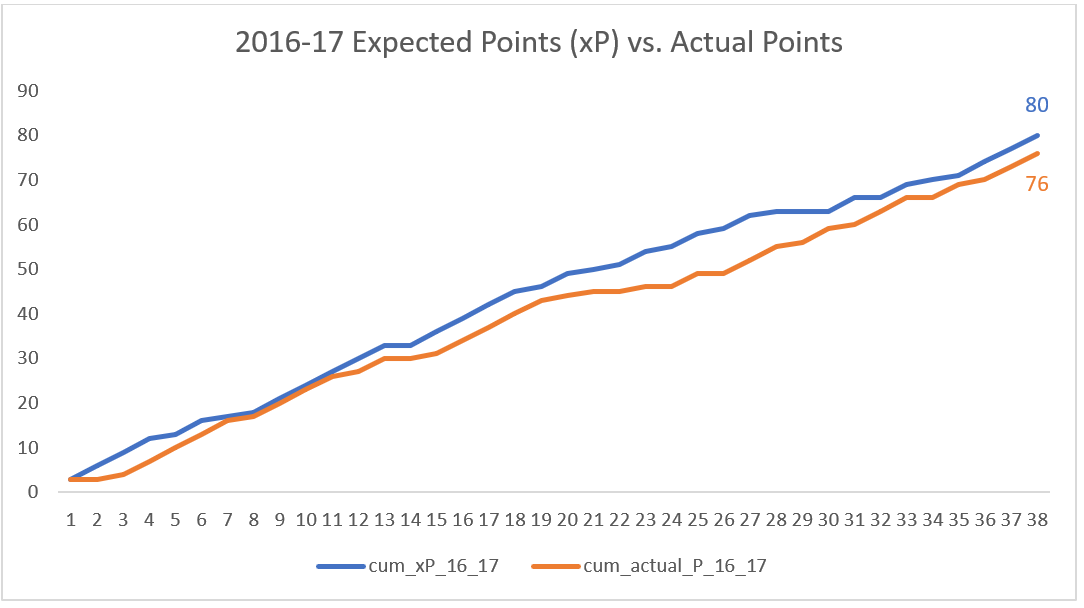
Note: Expected Points assumption – if xG-xGA delta for Liverpool was greater than 0.45, it was counted a win. Between -0.45, and 0.45 a draw. Less than -0.45 was considered a loss.
They followed it up with a top four finish but an underwhelming position in the title zone.
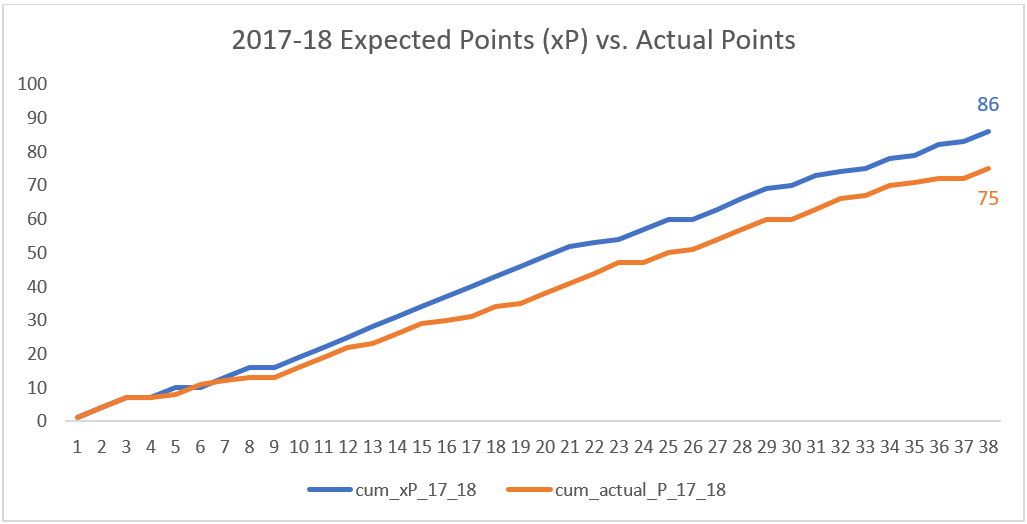
And thoroughly deserved to be champions if luck had sided with them.
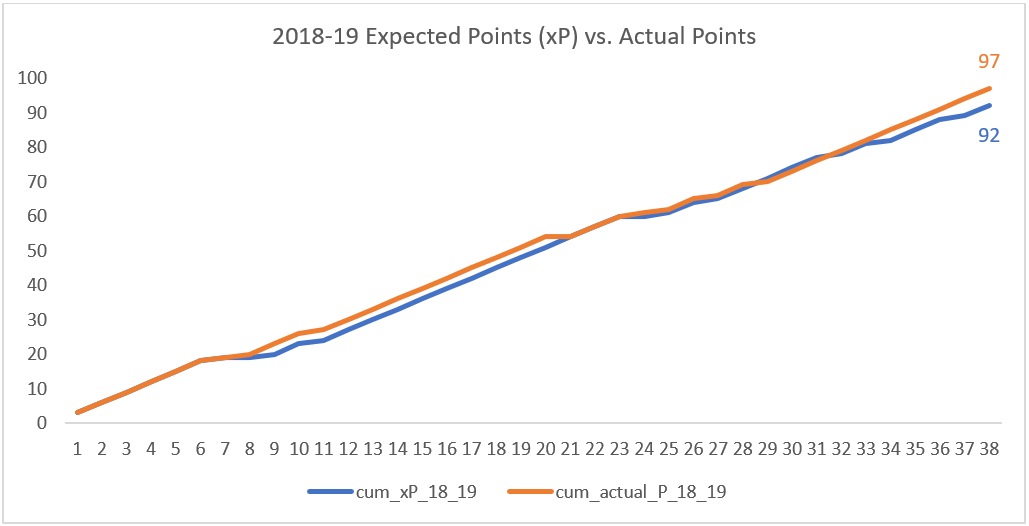
The other far-reaching issue that has occurred in the current gulf between 1st and 4th is that elite coaches like Guardiola, and Klopp have pushed the boundaries of football performances to new limits. If they continue to dominate it may seem that finishing 4th might not even qualify for the title zone.
The construct of a modern-day Klopp/Guardiola champion needs to have at least 31 victories.

32 wins gets you 96 points. This is a different world than the competitive years of Rafa and Mourinho between 2005-2010. If you had to be 90% sure of being a champion, that number increased by one more win.

And this is showcased by the current gap between 1st(82 points) and 4th (48 points) of 34 points (a reminder of the days when Chelsea’s wealth created this gulf, leading to more spending from the other title challengers or top-4). Here, a 29-win season with 87 points would make you a champion 90% of time.
As such, if Liverpool’s season is voided, and football somehow resumes for the following season to occur, do not be surprised if Liverpool continue the current streak of winning rate with another round of elite jumps.
Step jumps of throw ins (or how not to be an Andy Gray of idiots)
When Liverpool hired a throw-in coach, nobody envisaged the impact.
There was a small laughing matter courtesy of Andy Gray.
Yet Liverpool’s success in the area is now clearly documented as one of blindspot sporting jumps.
Stoke City executed tactics with Rory Delap but there wasn’t a widespread thought.
Sports like Basketball have strategies based around making the ball active after out of bounds play.
Such has been Thomas Grønnemark’s success that there are clubs hovering around him for recruitment, and even DW (Deutsche Welle is a Germany international broadcaster) came out with analysis of the impact created by Grønnemark.
So, the next time Klopp hires an expert, expect a step jump. And don’t be an idiot of Andy Gray proportions. [To be fair, that’s not easy! – Ed]

